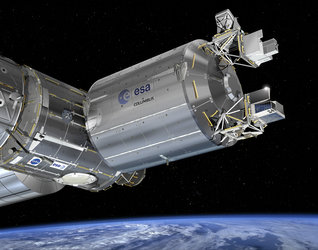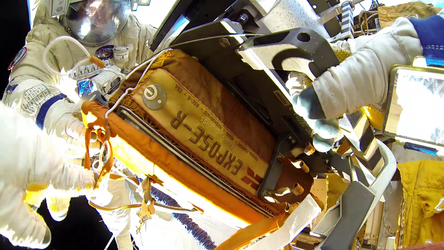Accept all cookies Accept only essential cookies See our Cookie Notice

About ESA
The European Space Agency (ESA) is Europe’s gateway to space. Its mission is to shape the development of Europe’s space capability and ensure that investment in space continues to deliver benefits to the citizens of Europe and the world.
Highlights
ESA - United space in Europe
This is ESA ESA facts Member States & Cooperating States Funding Director General Top management For Member State Delegations European vision European Space Policy ESA & EU Space Councils Responsibility & Sustainability Annual Report Calendar of meetings Corporate newsEstablishments & sites
ESA Headquarters ESA ESTEC ESA ESOC ESA ESRIN ESA EAC ESA ESAC Europe's Spaceport ESA ESEC ESA ECSAT Brussels Office Washington OfficeWorking with ESA
Business with ESA ESA Commercialisation Gateway Law at ESA Careers Cyber resilience at ESA IT at ESA Newsroom Partnerships Merchandising Licence Education Open Space Innovation Platform Integrity and Reporting Administrative Tribunal Health and SafetyMore about ESA
History ESA Historical Archives Exhibitions Publications Art & Culture ESA Merchandise Kids Diversity ESA Brand Centre ESA ChampionsLatest
Space in Member States
Find out more about space activities in our 23 Member States, and understand how ESA works together with their national agencies, institutions and organisations.
Science & Exploration
Exploring our Solar System and unlocking the secrets of the Universe
Go to topicAstronauts
Missions
Juice Euclid Webb Solar Orbiter BepiColombo Gaia ExoMars Cheops Exoplanet missions More missionsActivities
International Space Station Orion service module Gateway Concordia Caves & Pangaea BenefitsLatest
Space Safety
Protecting life and infrastructure on Earth and in orbit
Go to topicAsteroids
Asteroids and Planetary Defence Asteroid danger explained Flyeye telescope: asteroid detection Hera mission: asteroid deflection Near-Earth Object Coordination CentreSpace junk
About space debris Space debris by the numbers Space Environment Report In space refuelling, refurbishing and removingSafety from space
Clean Space ecodesign Zero Debris Technologies Space for Earth Supporting Sustainable DevelopmentApplications
Using space to benefit citizens and meet future challenges on Earth
Go to topicObserving the Earth
Observing the Earth Future EO Copernicus Meteorology Space for our climate Satellite missionsCommercialisation
ESA Commercialisation Gateway Open Space Innovation Platform Business Incubation ESA Space SolutionsLatest
Enabling & Support
Making space accessible and developing the technologies for the future
Go to topicBuilding missions
Space Engineering and Technology Test centre Laboratories Concurrent Design Facility Preparing for the future Shaping the Future Discovery and Preparation Advanced Concepts TeamSpace transportation
Space Transportation Ariane Vega Space Rider Future space transportation Boost! Europe's Spaceport Launches from Europe's Spaceport from 2012Latest

Space station space science
Thank you for liking
You have already liked this page, you can only like it once!
Careering around Earth every 90 minutes, 400 km above our heads, is the International Space Station – humanity’s orbital outpost.
The first permanent European research facility in space, the Columbus module – seen partially in the bottom right of this image – was delivered 10 years ago this week. It has been home to a multitude of microgravity experiments covering fluid physics, materials science and life sciences, many of which are relevant to broader topics in space science.
During the 2009 spacewalk pictured here, NASA astronauts John Olivas and Nicole Stott retrieved the European Technology Exposure Facility, which was attached outside Columbus, for return to Earth for analysis.
The facility, and the subsequent suites of ‘Expose’ experiments, hosted experiments requiring exposure to the space environment, such as the harsh vacuum of space, ultraviolet radiation from the Sun, and extreme freeze–thaw temperature cycles. The experiments held a variety of organisms exposed to such conditions for long periods, to test the limits of life. Bacteria, seeds, lichens and algae, as well as small organisms called tardigrades or ‘water bears’, have spent months enduring these conditions and returned to Earth alive and well, proving that life that can survive spaceflight.
Exobiology studies like this are particularly important for understanding if life could survive a journey through space between planets, or, for example, have endured the harsh conditions elsewhere in the Solar System. To that end, Expose had special compartments to recreate the martian atmosphere by filtering some sunlight and retaining some pressure, to investigate to what extent terrestrial life can cope with the extreme conditions on the Red Planet.
Exobiology is also at the heart of the ExoMars programme, which will launch a rover to Mars in 2020 to probe beneath the surface, to search for any signs that life may have existed on our neighbour planet.
The Solar Monitoring Observatory SOLAR, which studied the Sun with unprecedented accuracy across most of its spectral range, was also installed externally on Columbus. The instrument has contributed to solar and stellar physics and increased our knowledge of how the Sun interacts with Earth’s atmosphere, an important aspect in understanding what makes a planet habitable.
In the future, the Atmosphere–Space Interactions Monitor, ASIM, will be installed outside Columbus to monitor electric events at high altitudes. These include red sprites, blue jets and elves that are thought to be triggered by electrical discharges in the upper atmosphere. These powerful electrical charges can reach high above the stratosphere and have implications for how our atmosphere protects us from radiation from space.
A fascinating new experiment that will expand the range of research on Columbus is also coming soon with the addition of the Atomic Clock Ensemble in Space, ACES. Accurate to a second in 300 million years, it will enable the most precise measurement of time and frequency in space yet, essential to probe fundamental theories proposed by Albert Einstein with a precision that is impossible in laboratories on Earth.
Discover more science experiments – past, present and future – onboard the Columbus module here.
-
CREDIT
NASA/ESA -
LICENCE
ESA Standard Licence

Columbus laboratory

Columbus module

A decade of European science in space

Columbus is loaded into a transportation container a…















 Germany
Germany
 Austria
Austria
 Belgium
Belgium
 Denmark
Denmark
 Spain
Spain
 Estonia
Estonia
 Finland
Finland
 France
France
 Greece
Greece
 Hungary
Hungary
 Ireland
Ireland
 Italy
Italy
 Luxembourg
Luxembourg
 Norway
Norway
 The Netherlands
The Netherlands
 Poland
Poland
 Portugal
Portugal
 Czechia
Czechia
 Romania
Romania
 United Kingdom
United Kingdom
 Slovenia
Slovenia
 Sweden
Sweden
 Switzerland
Switzerland

























